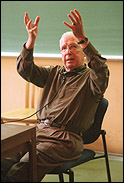Arthur Erickson: Concrete poet
| Arthur Erickson has been described as a philosopher as much as an architect. "Architecture has to be functional. But it should allow another dimension than what people are usually content to think about. It should open the perspective of the visitor to something they haven't experienced before. It shouldn't be ordinary or pedestrian."
 Architect Arthur Erickson
Architect Arthur EricksonPHOTO: Owen Egan |
|
The architect-philosopher -- who earned his Bachelor of Architecture in 1950 and an honorary doctorate in 1975 from McGill -- returned to the University for the homecoming weekend, where he addressed a crowd of colleagues, teachers, alumni and students.
A giant in Canadian architecture, Erickson contributed to the rebirth of modernism in Canada and is known for his rare ability to handle large-scale contemporary architecture that's sensitive to its environment.
He is the designer of several well-known public buildings, including the Canadian Embassy in Washington, DC, the San Diego Convention Center, Toronto's Roy Thomson Hall and Robson Square, Vancouver's three-block civic centre.
Erickson also created some of the most prominent modern university architecture through his designs for the University of Lethbridge and Simon Fraser University campuses as well as the UBC Museum of Anthropology.
He is the recipient of numerous awards, including the Royal Architectural Institute of Canada Gold Medal and the Gold Medal from the American Institute of Architects. A world traveller, he has completed work in the Middle East and China.
When Erickson studied architecture at McGill, he viewed American Frank Lloyd Wright as a role model, an architect whose work, at the time, was neither taught nor well respected by the faculty.
"Wright taught me things about the way I was thinking and feeling ... about my responses to sight. Once he exhibited his work in Europe, he inspired Europeans who came to North America to teach here. He gave Canada its heritage of modernism."
Erickson described how he and other budding modernists internalized that heritage. "Issues were clear and important to us. You felt you were a part of a revolution, a campaigner for ideas."
Moved also by abstract theories of space and time, Erickson saw beauty in the simplicity of objects. "Honesty was the rallying cry of early modernists and they reduced everything to absolute essentials. They got rid of the idea of style from the 19th and early 20th centuries."
Concrete is Erickson's trademark medium. With the exception of the Canadian Embassy, all of his major works were created with the substance and designed with it in mind. Erickson is passionate about concrete for its simplicity and functionality. "It's still a wonderful material. To cover a building with stone is to disguise its truth. I try to make concrete as beautiful as possible -- I treat it as a precious material."
In his lecture, Erickson expounded on the recent history of architecture.
"In the '80s, people were tired of modernism. It had become banal; its ideas weren't fresh any longer. The public was dying to get back to historicism, and they found that in the post-modern movement."
The Vancouver native makes no secret of his deep loathing of stylistic post-modern architecture. "In post-modernism, the establishment found something easy to sell. It was a delusionary movement." Erickson went on to describe how the post-modern aesthetic damaged North American culture.
"Disney, to me, is the great Satan of our period. After him, we had masses of people looking for entertainment in architecture. It changed the purpose of design. Now museums are becoming the flashiest places around and museum-going has become the new entertainment."
Erickson sees a present danger in the influence of the American post-modernist aesthetic around the world.
"I worry about architecture. I have judged some projects in China and there, I see the influence of the worst aspects of American architecture and the American developer. The Chinese are trying to find their own place and think that they can accomplish that by immediately imitating American art."
For a time, Erickson taught at the University of Oregon, and he's rebellious when it comes to the classroom, too. "I tell my students not to think. Thinking is the enemy of architecture. I tell people, you must feel your way and not think! Decades of rationalism have restricted the limits of thought. We simply cannot trust the brain.
"I'm against teaching," he told the audience. "You have to educate yourself. No one can tell you what information you need. Oregon was the only school that really knew what education was: no brains, no 'school of thought,' no curriculum. That was a great, great school."
Erickson touched on the issue of cultural heritage in Canada. "The Achilles heel in this country -- in all of North America -- is the lack of cultural confidence. We establish legitimacy only by reference to the past. Perhaps we're just too young. We have miscomprehensions of what we are. Too often, it comes when someone from the outside comes in and says 'you're okay.'"
But despite the disappointment with current trends in architecture, Erickson seemed somewhat above it all. Towards the close of the lecture, an audience member asked why he, the creator of some of the most important works in architecture in the last 50 years, is not better recognized in Canada. Erickson's answer was, oddly enough, not one of emotion but rather reason.
"I think it's fairly simple. I've just never fallen into the category of current theory."

